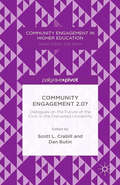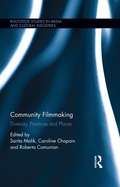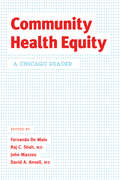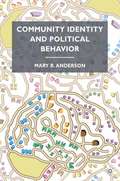- Table View
- List View
Community Energy in Germany: A Social Science Perspective
by Jörg RadtkeIn this ground-breaking book, Jörg Radtke offers for the first time within research, a comprehensive insight into the range of organizational structures of community energy projects in Germany and their contribution to the Energiewende. Based on nationwide quantitative survey data and in-depth analyses of selected case studies of solar, wind and geothermal projects, Radtke documents the social structure and motivations of participating citizens. He examines new forms of material participation, community building and co-determination within the mostly volunteer-led community energy projects based on the civic engagement patterns of active “green citizens”. The author identifies a new form of individualistic participation and collective modes of action in line with new types of project-oriented participation between business, politics and civil society within sustainability transformation processes of the early 21st century.
Community Engagement 2.0?: Dialogues On The Future Of The Civic In The Disrupted University (Community Engagement in Higher Education)
by Scott L. CrabillAs higher education is disrupted by technology and takes place less and less on campus, what does meaningful community engagement look like? How can it continue to enrich learning? In Community Engagement 2.0? , Crabill and Butin convene a dialogue: five writers set out theoretical and practical considerations, five more discuss the issues raised.
Community Fieldwork in Teacher Education: Theory and Practice (Routledge Research in Teacher Education)
by Heidi L Hallman Melanie BurdickIn teacher education, field work in community-based spaces (including foster homes and programs for homeless youth) is frequently contrasted with "traditional" field experiences in classroom settings, where beginning teachers are immediately introduced to teacher-centered models of instruction. This volume works against such a model, presenting a counter-narrative of new teachers’ understanding of the act of teaching. By exploring their work with at risk youth in community-based sites, the authors uncover how non-traditional spaces for teaching and learning have the potential to open new doors for reimagining the teaching act and teacher identity. This volume examines how prospective teachers have used writing within unconventional spaces as catalysts for considering what it means to become a teacher, as well as how the work of teaching can be conceptualized. It unites the practical aspects of field work and with theoretical conceptions of teaching, and envisions how the work and the definition of "teaching" can be broadened.
Community Fieldwork in Teacher Education: Theory and Practice (Routledge Research in Teacher Education)
by Heidi L Hallman Melanie BurdickIn teacher education, field work in community-based spaces (including foster homes and programs for homeless youth) is frequently contrasted with "traditional" field experiences in classroom settings, where beginning teachers are immediately introduced to teacher-centered models of instruction. This volume works against such a model, presenting a counter-narrative of new teachers’ understanding of the act of teaching. By exploring their work with at risk youth in community-based sites, the authors uncover how non-traditional spaces for teaching and learning have the potential to open new doors for reimagining the teaching act and teacher identity. This volume examines how prospective teachers have used writing within unconventional spaces as catalysts for considering what it means to become a teacher, as well as how the work of teaching can be conceptualized. It unites the practical aspects of field work and with theoretical conceptions of teaching, and envisions how the work and the definition of "teaching" can be broadened.
Community Filmmaking: Diversity, Practices and Places (Routledge Studies in Media and Cultural Industries)
by Sarita Malik Caroline Chapain Roberta ComunianThis book examines the role of community filmmaking in society and its connection with issues of cultural diversity, innovation, policy and practice in various places. Deploying a range of examples from Europe, North America, Australia and Hong Kong, the chapters show that film emerging from outside the mainstream film industries and within community contexts can lead to innovation in terms of both content and processes and a better representation of the cultural diversity of a range of communities and places. The book aims to situate the community filmmaker as the central node in the complex network of relationships between diverse communities, funding bodies, policy and the film industries.
Community Filmmaking: Diversity, Practices and Places (Routledge Studies in Media and Cultural Industries)
This book examines the role of community filmmaking in society and its connection with issues of cultural diversity, innovation, policy and practice in various places. Deploying a range of examples from Europe, North America, Australia and Hong Kong, the chapters show that film emerging from outside the mainstream film industries and within community contexts can lead to innovation in terms of both content and processes and a better representation of the cultural diversity of a range of communities and places. The book aims to situate the community filmmaker as the central node in the complex network of relationships between diverse communities, funding bodies, policy and the film industries.
A Community Guide to Social Impact Assessment: Fourth Edition
by Rabel J. BurdgeThe Guide is a tool for practitioners at all levels - social scientists, agency employees, community leaders, volunteers - to complete social impact assessments (SIAs) efficiently and effectively. The Guide is a how-to manual that provides the users with a step-by-step process easily followed by persons with minimal social science training. The Guide is organized into three sections: Chapters 1-6 provides the background, a short history, the conceptual model, the SIA scoping process and an explanation as to how to obtain data to measure SIA variables. Chapters 7-11 correspond to the five categories of SIA variables - population change, community and institutional arrangements, communities in transition, individual and family impacts and community infrastructure needs. Chapters 12-13 provide worksheets for summarizing SIA variables, and how resulting data may be used in the SIA mitigation/enhancement process.
A Community Health Approach to the Assessment of Infants and their Parents: The CARE Programme
by Kevin D. Browne Jo Douglas Catherine Hamilton-Giachritsis Jean HegartyThis book is a practical guide to the CARE programme, a home visiting programme that aims to assess infants? growth, development and psycho-social transitions in their first year of life and that together with the Index of Need checklist aims to engage parents in risk assessment. It provides evidence-based research for the programme, and gives clinical examples of how to use the assessment tools (including the Index of Need) and how to work with parents. The authors take a ?partnership with parents? approach throughout, while bearing in mind the practical workload issues that practitioners face.
Community Health Equity: A Chicago Reader
by David A. AnsellPerhaps more than any other American city, Chicago has been a center for the study of both urban history and economic inequity. Community Health Equity assembles a century of research to show the range of effects that Chicago’s structural socioeconomic inequalities have had on patients and medical facilities alike. The work collected here makes clear that when a city is sharply divided by power, wealth, and race, the citizens who most need high-quality health care and social services have the greatest difficulty accessing them. Achieving good health is not simply a matter of making the right choices as an individual, the research demonstrates: it’s the product of large-scale political and economic forces. Understanding these forces, and what we can do to correct them, should be critical not only to doctors but to sociologists and students of the urban environment—and no city offers more inspiring examples for action to overcome social injustice in health than Chicago.
Community Health Equity: A Chicago Reader
by David A. AnsellPerhaps more than any other American city, Chicago has been a center for the study of both urban history and economic inequity. Community Health Equity assembles a century of research to show the range of effects that Chicago’s structural socioeconomic inequalities have had on patients and medical facilities alike. The work collected here makes clear that when a city is sharply divided by power, wealth, and race, the citizens who most need high-quality health care and social services have the greatest difficulty accessing them. Achieving good health is not simply a matter of making the right choices as an individual, the research demonstrates: it’s the product of large-scale political and economic forces. Understanding these forces, and what we can do to correct them, should be critical not only to doctors but to sociologists and students of the urban environment—and no city offers more inspiring examples for action to overcome social injustice in health than Chicago.
Community Health Equity: A Chicago Reader
by David A. AnsellPerhaps more than any other American city, Chicago has been a center for the study of both urban history and economic inequity. Community Health Equity assembles a century of research to show the range of effects that Chicago’s structural socioeconomic inequalities have had on patients and medical facilities alike. The work collected here makes clear that when a city is sharply divided by power, wealth, and race, the citizens who most need high-quality health care and social services have the greatest difficulty accessing them. Achieving good health is not simply a matter of making the right choices as an individual, the research demonstrates: it’s the product of large-scale political and economic forces. Understanding these forces, and what we can do to correct them, should be critical not only to doctors but to sociologists and students of the urban environment—and no city offers more inspiring examples for action to overcome social injustice in health than Chicago.
Community Health Equity: A Chicago Reader
by Fernando De Maio David A. Ansell John Mazzeo Raj C. ShahPerhaps more than any other American city, Chicago has been a center for the study of both urban history and economic inequity. Community Health Equity assembles a century of research to show the range of effects that Chicago’s structural socioeconomic inequalities have had on patients and medical facilities alike. The work collected here makes clear that when a city is sharply divided by power, wealth, and race, the citizens who most need high-quality health care and social services have the greatest difficulty accessing them. Achieving good health is not simply a matter of making the right choices as an individual, the research demonstrates: it’s the product of large-scale political and economic forces. Understanding these forces, and what we can do to correct them, should be critical not only to doctors but to sociologists and students of the urban environment—and no city offers more inspiring examples for action to overcome social injustice in health than Chicago.
Community Health Equity: A Chicago Reader
by Fernando De Maio David Ansell John Mazzeo Raj ShahPerhaps more than any other American city, Chicago has been a center for the study of both urban history and economic inequity. Community Health Equity assembles a century of research to show the range of effects that Chicago’s structural socioeconomic inequalities have had on patients and medical facilities alike. The work collected here makes clear that when a city is sharply divided by power, wealth, and race, the citizens who most need high-quality health care and social services have the greatest difficulty accessing them. Achieving good health is not simply a matter of making the right choices as an individual, the research demonstrates: it’s the product of large-scale political and economic forces. Understanding these forces, and what we can do to correct them, should be critical not only to doctors but to sociologists and students of the urban environment—and no city offers more inspiring examples for action to overcome social injustice in health than Chicago.
Community Health Equity: A Chicago Reader
Perhaps more than any other American city, Chicago has been a center for the study of both urban history and economic inequity. Community Health Equity assembles a century of research to show the range of effects that Chicago’s structural socioeconomic inequalities have had on patients and medical facilities alike. The work collected here makes clear that when a city is sharply divided by power, wealth, and race, the citizens who most need high-quality health care and social services have the greatest difficulty accessing them. Achieving good health is not simply a matter of making the right choices as an individual, the research demonstrates: it’s the product of large-scale political and economic forces. Understanding these forces, and what we can do to correct them, should be critical not only to doctors but to sociologists and students of the urban environment—and no city offers more inspiring examples for action to overcome social injustice in health than Chicago.
Community Health Needs in South Africa
by Ntombenhle Protasia TorkingtonThis title was first published in 2000: Although the apartheid regime has now been abolished there is still a great deal of work to be done in order to eliminate the disadvantages it created for the health of black people at both micro and macro levels. This book presents the findings of a study commissioned to assess and respond to the health needs of black people in South Africa. The hope expressed by those who participated is that the study is considered within the wider context of understanding the apartheid system and the scars it left behind. Community Health Needs in South Africa represents an excellent example of how action research can be used as a tool to make a difference in people’s lives.
Community Health Needs in South Africa (Routledge Revivals Ser.)
by Ntombenhle Protasia TorkingtonThis title was first published in 2000: Although the apartheid regime has now been abolished there is still a great deal of work to be done in order to eliminate the disadvantages it created for the health of black people at both micro and macro levels. This book presents the findings of a study commissioned to assess and respond to the health needs of black people in South Africa. The hope expressed by those who participated is that the study is considered within the wider context of understanding the apartheid system and the scars it left behind. Community Health Needs in South Africa represents an excellent example of how action research can be used as a tool to make a difference in people’s lives.
Community Health Systems In The Rural American South: Linking People And Policy
by Carole E HillA cultural perspective of health care systems can provide health care providers and policymakers with a broader understanding of the issues they face when planning and implementing new health programs in communities. Healthcare tales place in a community setting while health care policy is developed at an entirely different level in the larger socioeconomic system. In this study the author attempts to link the community level systems of health with those of the policy level system and allow for a comparison of the convergence and divergence of people's health beliefs and behavior with those of policymakers and of medical anthropology in Coberly.
Community Health Systems In The Rural American South: Linking People And Policy
by Carole E HillA cultural perspective of health care systems can provide health care providers and policymakers with a broader understanding of the issues they face when planning and implementing new health programs in communities. Healthcare tales place in a community setting while health care policy is developed at an entirely different level in the larger socioeconomic system. In this study the author attempts to link the community level systems of health with those of the policy level system and allow for a comparison of the convergence and divergence of people's health beliefs and behavior with those of policymakers and of medical anthropology in Coberly.
Community Identity and Political Behavior
by M. AndersonThe focus of this book is on how community comes to influence political behaviour; it takes an interdisciplinary approach blending the fields of community psychology, sociology, and political science.
The Community in Rural America (Society and Natural Resources Book Series)
by Kenneth P. WilkinsonThe Community in Rural America, by Kenneth P. Wilkinson, is a foundational theoretical work that both defines the interactional approach to the study of the community in rural areas and frames its application to encourage and promote rural community development. Recognized for its detailed theoretical construction and logic for understanding human interactions, this book has been widely adopted and used by researchers, extension faculty, and community development practitioners for over thirty years. Presenting Wilkinson’s groundbreaking work in its original form, with a new foreword aimed at clarifying several key concepts in interactional theory, this edition of The Community in Rural America will appeal to new students of the community as well as established scholars in the field.
Community in the Balance: Morality and Social Change in an Indonesian Society
by James HagenCommunity in the Balance presents a fresh perspective on some classic social science issues. It examines the conflicts and tensions that permeate day-to-day interactions of a people in a remote region of the eastern Indonesian province of Maluku. The Maneo openly tout the pleasures of living alone in the forests of Seram away from the demands of kith and kin and the scrutiny that comes from life in villages in close proximity. The option is real. Yet while the incessant social demands and low-level enmities they attribute to village life are also felt, most acutely in the peril of sorcery, the accounts of strife are exaggerated to help establish the mutuality of the terms on which people do associate-as a collective sacrifice and virtue. Drawing on Aristotelian ideas of morality and exploring the modalities of recognition, desire, and displacement, the book focuses on the strategies of negotiation and obfuscation Maneo employ to foster community life. As volition is central to moral practice, the book's analysis of the subsequent religious conflagration that swept the province between 1999 and 2002 illuminates how fears and rumors of attack narrowed options that might otherwise have enabled enough people to opt out, condemn the violence, and perhaps contain it.
Community in the Balance: Morality and Social Change in an Indonesian Society
by James HagenCommunity in the Balance presents a fresh perspective on some classic social science issues. It examines the conflicts and tensions that permeate day-to-day interactions of a people in a remote region of the eastern Indonesian province of Maluku. The Maneo openly tout the pleasures of living alone in the forests of Seram away from the demands of kith and kin and the scrutiny that comes from life in villages in close proximity. The option is real. Yet while the incessant social demands and low-level enmities they attribute to village life are also felt, most acutely in the peril of sorcery, the accounts of strife are exaggerated to help establish the mutuality of the terms on which people do associate-as a collective sacrifice and virtue. Drawing on Aristotelian ideas of morality and exploring the modalities of recognition, desire, and displacement, the book focuses on the strategies of negotiation and obfuscation Maneo employ to foster community life. As volition is central to moral practice, the book's analysis of the subsequent religious conflagration that swept the province between 1999 and 2002 illuminates how fears and rumors of attack narrowed options that might otherwise have enabled enough people to opt out, condemn the violence, and perhaps contain it.
Community in Twentieth-Century Fiction
by Paula Martín Salván, Gerardo Rodríguez Salas and Julián Jiménez HeffernanThis book focuses on the imaginary construction and deconstruction of human communities in modern and contemporary fiction. Drawing on recent theoretical debate on the notion of community (Nancy, Blanchot, Badiou, Esposito), this collection examines narratives by Joyce, Mansfield, Davies, Naipaul, DeLillo, Atwood and others.
Community Informatics: Shaping Computer-Mediated Social Networks
by Dave Eagle Barry Hague Leigh Keeble Brian D. LoaderCommunity groups, social support networks, voluntary agencies and government organisations are all actively exploring the potential of the new information and communication technologies to bring about democratic development and renewal. A rich variety of social experiments in what has become known as Community Informatics is now beginning to provide useful research findings and exciting examples of innovative applications.This book sets down some of the defining features of a Community Informatics approach and some of the common themes which are emerging. In particular it considers the following issues:* sustainability* employment* community management* public service provision* partnerships of stakeholders* local learning* social support and networks.This edited collection brings together leading exponents of Community Informatics from around the world and critically evaluates their experiences.
Community Informatics: Shaping Computer-Mediated Social Networks
by Leigh Keeble Brian D. LoaderCommunity groups, social support networks, voluntary agencies and government organisations are all actively exploring the potential of the new information and communication technologies to bring about democratic development and renewal. A rich variety of social experiments in what has become known as Community Informatics is now beginning to provide useful research findings and exciting examples of innovative applications.This book sets down some of the defining features of a Community Informatics approach and some of the common themes which are emerging. In particular it considers the following issues:* sustainability* employment* community management* public service provision* partnerships of stakeholders* local learning* social support and networks.This edited collection brings together leading exponents of Community Informatics from around the world and critically evaluates their experiences.













